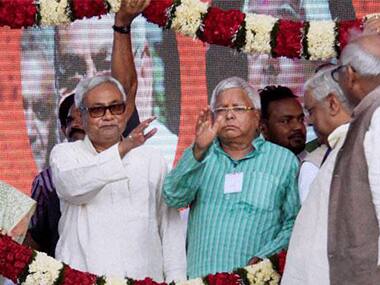By Ajay Singh Just a day before the Patna rally of the Grand Secular Alliance on August 30, posters came up all across the city mocking the claims of the Bihar government. The BJP had carefully planned the timing of their campaign to take the wind out of Nitish Kumar’s campaign that says “Bihar me bahar ho, Nitish Kumar ho (Bihar will prosper if Nitish Kumar wins).” Much in the mould of a personality-based hi-tech campaign that Narendra Modi has come to be known for, the days preceding the rally saw lakhs of Patna citizens being serenaded by Nitish Kumar, who sent audio invitations on mobile phones to join the Swabhiman rally. This is hardly surprising because managing this modern social media-centric campaign is Prashant Kishore, who was one of the many who handled Modi’s 2014 campaign. Of course, there are doubts on whether Bihar is ready for such a campaign. However, set against this backdrop of a cutting-edge digital warfare, the Swabhiman rally is glaring in its contrast of old-world realpolitik on display. [caption id=“attachment_2414848” align=“alignleft” width=“380” class=” “]  Image courtesy: PTI[/caption] To meet the challenge posed by Narendra Modi, Nitish has created a strange hybrid of his own sophisticated social media marketing strategies and Lalu Yadav’s frozen-in-time political idioms. In the din of this marketing-driven election campaign, the most worrying aspect about Bihar is being ignored. Political idioms and rhetorical statements are being liberally used to take the state back to a dreadful past when caste acrimony paid rich political dividends. Lalu Prasad played the card to the hilt and warned the upper castes, particularly Bhumihars, in not-so-subtle ways, of ushering in Mandal part II in the state. “This not a Bihar of pre-nineties,” he proclaimed from the dais much to the discomfiture of not just Nitish but also Congress president Sonia Gandhi, whose support base included upper castes. In Bihar’s society, caste cleavages run so deep that Lalu’s rhetoric to foment caste hostilities has immense potential to expose the fault lines. Only a week back, this came to the fore in Arah where upper castes and OBCs came to blows. There are pockets throughout the state where caste rivalries are being stoked to light up the political fight of the year. This is one side of the story. The other is equally worrying. According to records of the the Bihar administration, Hindutva forces are no less determined in their efforts to polarise the electorate on religious lines. A senior functionary of the Bihar government admits that the police are overstretched in communally sensitive districts. “Everyday, we get reports of minor incidents taking communal overtones,” he says. Nitish appears to see it as a part of larger conspiracy to upset his caste calculations. By all indications, Bihar is marching inevitably towards a tragedy. Contrast this situation with a new optimism that had emerged in Bihar about eight years ago. After decades of non-governance, Nitish resurrected Bihar’s institutions of governance and gave a new hope to the people. Girls riding bicycles in groups to schools created a new imagery defying the stereotype of an unruly and ungovernable Bihar. Just after his stunning 2010 re-election, Nitish had proclaimed that his “last battle would be to rid Bihar of casteism” altogether. The Swabhiman rally is nothing less than a tragedy for Bihar, as it was a rally which saw Nitish sitting passively listening to Lalu’s brazen caste rants. Lalu’s exhortation that he and Nitish, sons of OBCs, would bring backward classes under the grand coalition’s political umbrella literally flew in the face of all that Nitish has stood for all these years. Lalu’s strategy of stoking caste hostilities may pay immediate electoral dividends, but it will run contrary to Nitish’s ‘new Bihar’ narrative. Nobody knows that better than Nitish. In this context, though Gandhi Maidan was overflowing with people brought in from across the state by the Grand Secular Alliance, the Patna rally will be remembered for its definite political approach of reviving a dreadful forgotten past. Of course, Lalu’s rhetoric did not electrify the crowds as it used to back in the nineties. But it would be naive to take solace from this calm at the surface level, as there are clear signs of attempts at a violent stirring one scratch under the surface.
Political idioms and rhetorical statements are being liberally used to take Bihar back to a dreadful past when caste acrimony paid rich political dividends.
Advertisement
End of Article
Written by FP Archives
see more


)
)
)
)
)
)
)
)
)



